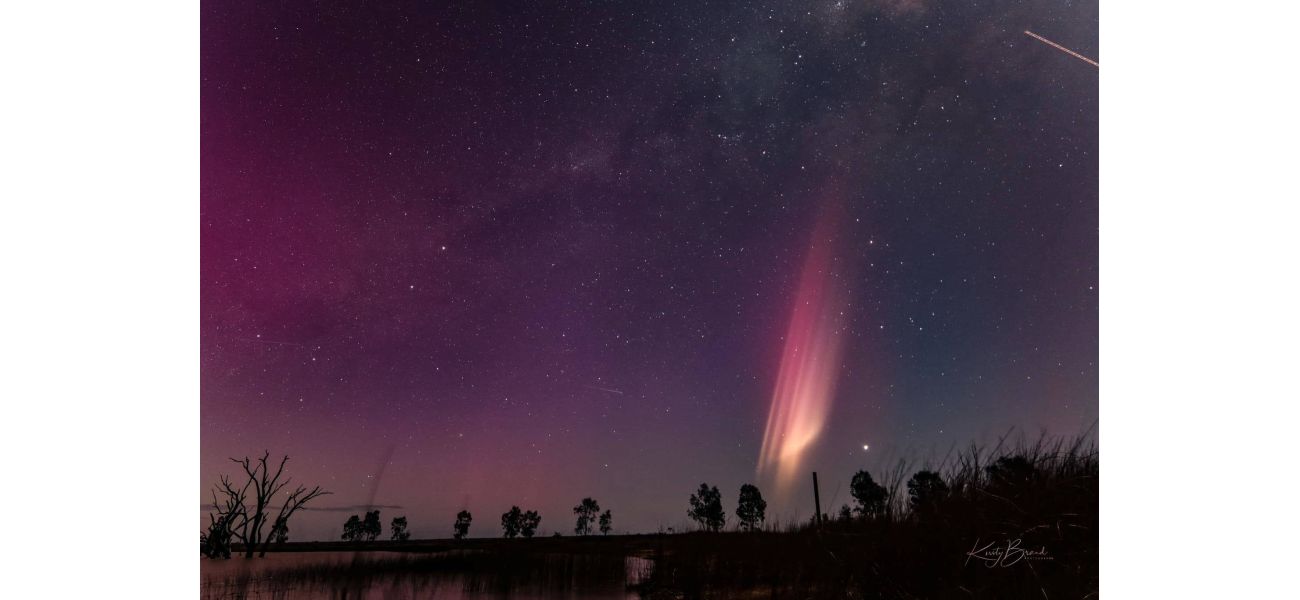Photographers have captured a lucky photograph of a mysterious streak of light known as 'Steve'.
Unique event in middle of southern lights.
October 15th 2024.

The sky above Australia was graced with a breathtaking sight as the rare atmospheric phenomenon known as "Steve" made a brief appearance. This unique spectacle, which has earned the nickname "Steve" due to its anagram for "strong thermal emission velocity enhancement," is a vibrant ribbon of hot gas that lights up the night sky with a colorful purple streak. Similar to its cousins, the aurora borealis and australis, Steve is a rare event that is not always visible from the ground.
However, on a lucky Friday night, stargazers in South Australia and Victoria were able to catch a glimpse of Steve as it made a sneaky dash across the night sky. One such lucky observer was Sarah Longcor, who was photographing the aurora with her daughter when she noticed Steve streaking through the pink geomagnetic storm. Excitedly, she exclaimed, "Old mate Steve-o showed up last night! What a treat to be under the stars with my daughter and witness the beautiful lady Aurora once again."
Another photographer, Kirsty Brand, also captured stunning images of Steve near Taylors Lake in Horsham, Victoria. She shared her photos and expressed her gratitude, saying, "I feel blessed to have seen and captured Steve, along with a spectacular meteor." The sightings of Steve were not limited to just Victoria, as many South Australians in the state's south-east were also treated to the rare phenomenon on Friday.
Last week, the Bureau of Meteorology had predicted unusual solar activity that could lead to visible aurora australis, also known as southern lights, on Thursday, Friday, and Saturday nights. As a result, photographers across the country were on the lookout for the vibrant pink and purple hues in the sky. However, only a lucky few were able to witness the elusive Steve in all its glory.
Unlike the aurora, which is caused by particles, Steve is a reflection of hot, glowing gases. It was first discovered by Canadian scientists in 2015 and 2016 while they were studying the aurora. Toshi Nishimura, a researcher at Boston University and co-author of the original Steve paper, shared, "After Steve gained popularity, scientists went back to historical observations of the aurora and realized that a Steve-like phenomenon had been reported back in the 1890s and 1910s." He explained that although there were no colored photographs back then, the descriptions of "a luminous band...like a straight tail of a large comet" match the characteristics of Steve.
The name "Steve" was chosen as a nod to the hedge of the same name in the children's animated movie, Over the Hedge. This unique and dazzling phenomenon continues to captivate observers and researchers alike, providing a rare and unforgettable experience for those fortunate enough to witness it.
However, on a lucky Friday night, stargazers in South Australia and Victoria were able to catch a glimpse of Steve as it made a sneaky dash across the night sky. One such lucky observer was Sarah Longcor, who was photographing the aurora with her daughter when she noticed Steve streaking through the pink geomagnetic storm. Excitedly, she exclaimed, "Old mate Steve-o showed up last night! What a treat to be under the stars with my daughter and witness the beautiful lady Aurora once again."
Another photographer, Kirsty Brand, also captured stunning images of Steve near Taylors Lake in Horsham, Victoria. She shared her photos and expressed her gratitude, saying, "I feel blessed to have seen and captured Steve, along with a spectacular meteor." The sightings of Steve were not limited to just Victoria, as many South Australians in the state's south-east were also treated to the rare phenomenon on Friday.
Last week, the Bureau of Meteorology had predicted unusual solar activity that could lead to visible aurora australis, also known as southern lights, on Thursday, Friday, and Saturday nights. As a result, photographers across the country were on the lookout for the vibrant pink and purple hues in the sky. However, only a lucky few were able to witness the elusive Steve in all its glory.
Unlike the aurora, which is caused by particles, Steve is a reflection of hot, glowing gases. It was first discovered by Canadian scientists in 2015 and 2016 while they were studying the aurora. Toshi Nishimura, a researcher at Boston University and co-author of the original Steve paper, shared, "After Steve gained popularity, scientists went back to historical observations of the aurora and realized that a Steve-like phenomenon had been reported back in the 1890s and 1910s." He explained that although there were no colored photographs back then, the descriptions of "a luminous band...like a straight tail of a large comet" match the characteristics of Steve.
The name "Steve" was chosen as a nod to the hedge of the same name in the children's animated movie, Over the Hedge. This unique and dazzling phenomenon continues to captivate observers and researchers alike, providing a rare and unforgettable experience for those fortunate enough to witness it.
[This article has been trending online recently and has been generated with AI. Your feed is customized.]
[Generative AI is experimental.]
0
0
Submit Comment





